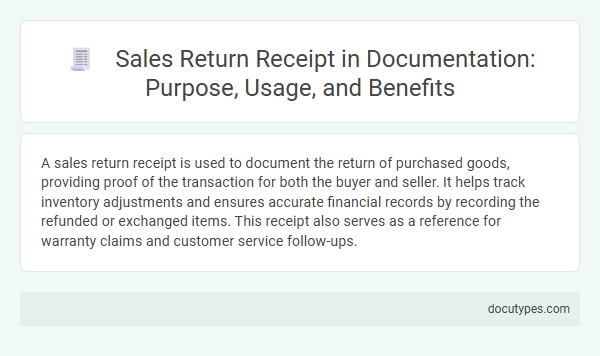A sales return receipt is used to document the return of purchased goods, providing proof of the transaction for both the buyer and seller. It helps track inventory adjustments and ensures accurate financial records by recording the refunded or exchanged items. This receipt also serves as a reference for warranty claims and customer service follow-ups.
Introduction to Sales Return Receipt
A sales return receipt is a document issued when a customer returns a purchased item. It serves as proof of the return transaction between the buyer and seller.
This receipt helps track returned merchandise, ensuring accurate inventory management and financial records. Your business can use it to process refunds or exchanges efficiently. It also provides a clear record for auditing and customer service purposes.
Purpose of a Sales Return Receipt Document
A sales return receipt is used to document the return of goods from a customer to a business. It serves as proof of the transaction and helps track inventory adjustments and refunds. Your business relies on this document to maintain accurate financial records and ensure customer satisfaction.
Key Components of Sales Return Receipts
A sales return receipt documents the details of returned products and the corresponding refund or exchange. It serves as official proof for both the seller and buyer regarding the transaction reversal.
- Customer Information - Includes the name and contact details of the person returning the item.
- Return Date - Records the exact date when the product was returned to the seller.
- Item Details - Lists the products being returned, including quantity, description, and reason for return.
- Refund Amount - Specifies the amount refunded or credited back to the customer.
- Transaction Reference - Connects the return to the original sales transaction for accurate record-keeping.
Your accurate sales return receipt ensures transparent and efficient processing of returned goods.
Steps in Issuing a Sales Return Receipt
A sales return receipt is used to document the return of goods by a customer, ensuring accurate record-keeping for both the seller and buyer. It serves as proof of the transaction reversal, detailing the items returned, quantities, and refund or credit issued. Issuing this receipt helps maintain inventory accuracy and supports financial reconciliation.
The first step involves verifying the returned items match the original sales details, including purchase date and condition. Next, update the inventory system to reflect the returned products and process the appropriate refund or store credit. Finally, generate the sales return receipt, providing a clear record for your accounting and customer service.
Retaining a copy of the sales return receipt facilitates future reference in case of disputes or warranty claims. Proper documentation aids in tracking return trends and managing customer satisfaction. Ensuring every return is documented protects your business's financial and operational integrity.
Legal Importance of Sales Return Receipts
A sales return receipt serves as an official record documenting the return of purchased goods. It is crucial in protecting both the buyer's and seller's legal rights during a transaction reversal.
- Proof of Transaction - A sales return receipt provides legal evidence that the returned items were originally purchased, preventing disputes over the validity of the return.
- Compliance With Return Policies - It helps ensure that returns comply with the seller's stated refund or exchange policy, which can be important in legal scenarios.
- Financial Accountability - The receipt records adjustments to inventory and finances, supporting accurate bookkeeping necessary for audits and legal verification.
Usage of Sales Return Receipts in Accounting
| What Is a Sales Return Receipt Used For? |
|---|
| A sales return receipt documents the return of goods from a customer to a seller. It serves as proof of the transaction reversal and outlines details such as the items returned, their quantities, and the refund or credit issued. This receipt plays a critical role in maintaining accurate records of returned merchandise. |
| Usage of Sales Return Receipts in Accounting |
| In accounting, sales return receipts help adjust revenue figures by recording reductions in sales due to returned products. They ensure that the accounts receivable balances are updated correctly and inventory records are adjusted to reflect the returned stock. These receipts also aid in preparing accurate financial statements by reflecting net sales after returns. For Your business, using sales return receipts supports effective tracking of customer returns, enhances audit trails, and improves overall financial data accuracy. |
Benefits of Proper Sales Return Documentation
What is a sales return receipt used for? A sales return receipt serves as proof of the return transaction between a customer and a business. It documents key details like the returned items, date, and refund amount to ensure accurate record-keeping.
What are the benefits of proper sales return documentation? Proper documentation helps prevent disputes by providing clear evidence of the return. It also supports inventory management and financial auditing, improving overall business transparency and customer trust.
Common Mistakes in Sales Return Receipts
A sales return receipt is used to document the return of goods by a customer, ensuring accurate record-keeping and inventory management. It serves as proof of the transaction reversal for both the seller and buyer.
Common mistakes in sales return receipts include incorrect product descriptions and missing return dates, which can lead to inventory errors and customer disputes. You should always verify details to maintain accurate financial records and improve customer service.
Digital vs. Paper Sales Return Receipts
A sales return receipt documents the return of purchased goods, providing proof for both the buyer and seller. It facilitates tracking refunds, exchanges, and inventory adjustments.
- Digital Sales Return Receipt - Enables easy access and storage via email or apps, reducing paper waste and improving record keeping.
- Paper Sales Return Receipt - Offers a tangible copy for customers who prefer physical documentation or lack digital access.
- Purpose of Sales Return Receipts - Ensures accountability by confirming the transaction of returned items, helping prevent disputes and errors.
What Is a Sales Return Receipt Used For? Infographic

